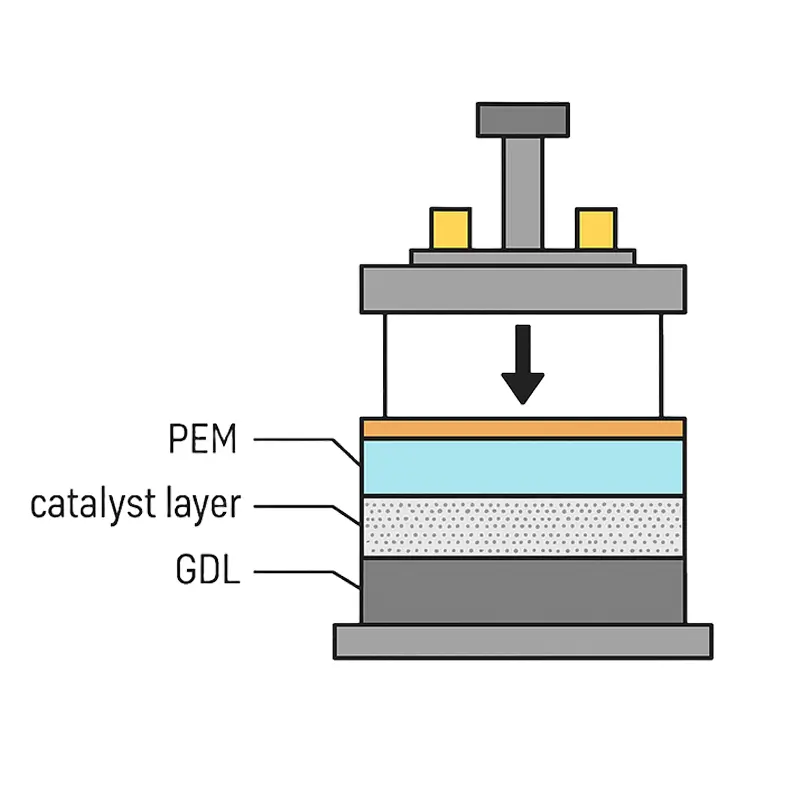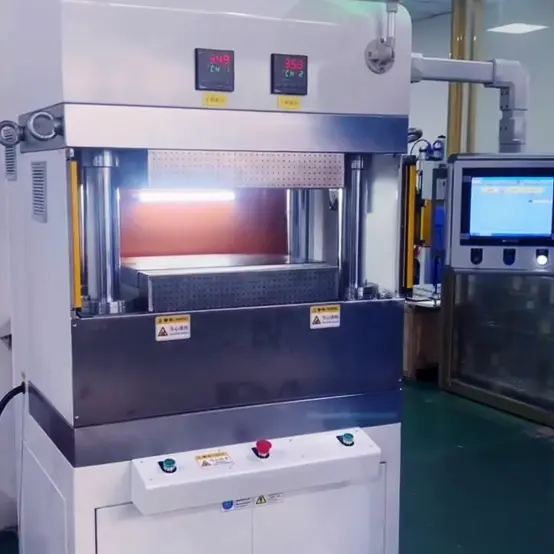The membrane electrode assembly (MEA) is the core component of hydrogen fuel cells, and its manufacturing quality directly determines the cell’s output performance, durability, and cost competitiveness. As the key step that defines the bonding quality between the catalyst layer, proton exchange membrane (PEM), and gas diffusion layer (GDL), the hot-pressing process places extremely high demands on pressure accuracy, temperature control, and long-term stability.
However, due to ultra-thin materials, fragile mechanical properties, and a very narrow thermal-processing window, MEA hot-pressing has become one of the most challenging bottlenecks in hydrogen energy industrialization.

Hydrogen Fuel Cell MEA Manufacturing
(For confidentiality purposes, the product images shown are representative illustrations only and do not depict actual client-specific product)
Combining high-precision force control, programmable pressure curves, flexible initial contact control, and full-process data traceability, XIRO servo press machine provides a breakthrough hot-pressing solution for MEA manufacturers. This article systematically analyzes the technical challenges of MEA hot-pressing and presents how the servo press machine addresses these pain points.
Ⅰ.Six Major Challenges in MEA Hot-Pressing
1. Damage-Free Handling of Ultra-Thin and Fragile Materials
The PEM is only 10–20 μm thick, the catalyst layer is a nanostructured porous material, the GDL is mechanically fragile, and the sealing frame is made of soft polymer. These properties result in extremely high sensitivity during hot-pressing.
Typical risks include:
Initial contact shock causing PEM puncture
Catalyst layer pore collapse or powder loss
Localized damage or delamination of the GDL
A precision-controlled press machine is essential to prevent mechanical damage.
2. Extremely Tight Thermo-Mechanical Coupling Requirements
The PEM hot-pressing window is typically:
130–150°C
0.5–2 MPa pressure
Dozens of seconds to several minutes
To achieve PEM softening (not melting) and molecular interpenetration between the ionomer, catalyst and PEM chains, the temperature and pressure must be tightly coordinated.
Common issues include:
Excessive temperature → PEM melting & reduced proton conductivity
Insufficient temperature → Higher interfacial resistance
Excessive pressure → Catalyst layer pore compression & impaired gas transport
Insufficient pressure → Poor interfacial bonding
These characteristics make MEA production highly dependent on precise servo-controlled hot-pressing equipment.
3. Alignment Difficulty & Thermal Expansion Mismatch Across Multiple Layers
MEA/CCM assembly typically requires precise stacking of 5–7 layers (release film, PEM, catalyst layer, GDL, sealing frame), with an alignment accuracy requirement of ≤0.1 mm.
Thermal expansion mismatch is a major challenge:
PEM expansion coefficient: extremely high
GDL expansion: much lower
Difference between the two can reach 20×
With a 100°C temperature rise, materials can exhibit 0.1–0.2 mm differential expansion, leading to:
Misalignment
Frame welding offset
GDL intrusion into PEM regions
Real-time compensation is crucial for consistent MEA quality.
4. High Requirements for Pressure-Holding Stability
MEA hot-pressing typically requires stable pressure for tens of seconds to several minutes, with a strict stability requirement of < ±1%.
Traditional hydraulic presses face issues:
Oil temperature drift causing pressure fluctuation
Slow response, unable to compensate in time
Poor long-term pressure stability
A servo press machine provides closed-loop force control significantly better suited for this application.
5. Full Process Traceability Requirements
MEA performance is highly sensitive to:
Pressure ramp rate (affects layer slippage)
Temperature uniformity
Micro-scale displacement changes
Real-time pressure compensation
Complete capture of pressure–time, temperature–time, and displacement–time curves is essential.
For modern MEA manufacturing, high-frequency sampling ≥100 Hz is required (far above the 10 Hz capability of conventional systems).
6. Stringent Cleanliness and Anti-Contamination Requirements
PEM is highly sensitive to metal-ion contamination (>5 ppm can cause failure).
GDL and catalyst layers readily absorb oil mist, particles, or volatile residues.
Hot-pressing equipment must avoid:
Metal ion contamination
Oil contamination (common in hydraulic systems)
Particulate and chemical residues
Heating plate material corrosion
A clean, oil-free press machine is mandatory in MEA production.
Ⅱ. XIRO Servo Press Machine Solutions for MEA Hot-Pressing
1. High-Precision Force Control System
Multi-stage soft-press initialization
Ultra-low initial force ≤0.1 MPa prevents PEM and catalyst layer damage.
High-precision parallelism
Press plate parallelism reaches ≤0.02 mm/m², ensuring uniform force distribution.
High-resolution displacement control
Servo motion accuracy reaches ±0.01 mm, ensuring smooth press-plate engagement without impact.
Programmable pressure curves
Supports S-curve, exponential, and stepwise pressing modes to reduce internal stress and optimize bonding.
2. Temperature–Pressure Coordination System
±1°C heating uniformity
Ensures consistent temperature across the active MEA area.
Intelligent temperature–pressure matching
Precise control to ensure PEM softening, ionomer flow, catalyst integration, and frame bonding activation.
Three-stage thermal management:
Heating stage: prevents premature material sliding
Holding stage: ensures molecular-chain interpenetration
Cooling stage: minimizes internal stress and delamination risk

XIRO Servo Press Machine for MEA Hot-Pressing (Customizable )
3. Visual Alignment & Thermal Expansion Compensation
High-resolution CCD vision alignment (≤50 μm)
Ensures accurate initial stacking of PEM, CCM, GDL, and sealing frames.
Pre-press fixation
Low-force pre-press stabilizes all layers, preventing slippage during high-pressure hot-pressing.
Thermal expansion compensation algorithm
Real-time correction based on CTE values and temperature rise to ensure perfect layer alignment.
4. Stable Pressure-Holding & Energy Efficiency
Full closed-loop servo force control (< ±0.5% deviation)
Ensures stable hot-pressing even during long cycles.
Zonal heating + liquid cooling
Reduces energy consumption and maintains thermal stability.
High-rigidity frame (< 0.005 mm deformation)
Ensures no structural relaxation during pressure holding.
5. Complete Data Traceability
100+ process-recipes storage
Supports fast changeover for multiple MEA types.
Real-time data recording
Pressure/time, temperature/time, displacement/time curves automatically stored.
Built-in SPC analysis
Predicts GDL compression behavior, catalyst densification trends, and process drift.
6. Cleanroom-Compatible Structural Design
Fully electric drive, oil-free
Sealed pressing chamber to prevent particle intrusion
Heating plate built with corrosion-resistant materials (e.g., 316L stainless steel)
Designed for long-term stable operation in high-cleanliness fuel cell production lines.
Ⅲ. Conclusion
XIRO servo press machine provides a highly reliable, high-precision solution for MEA hot-pressing—addressing critical industry challenges such as pressure stability, thermal management, layer alignment, and contamination control.
Compared with traditional hydraulic presses, the servo press machine offers:
Higher consistency
Better repeatability
Complete process traceability
Cleaner, more intelligent operation
As the hydrogen energy industry moves towards higher performance and lower cost, servo press machines will become the mainstream equipment choice for large-scale MEA manufacturing. XIRO's advanced hot-pressing technology empowers manufacturers to achieve higher-quality MEA production with stronger process control, improved yield rates, and superior long-term reliability.






